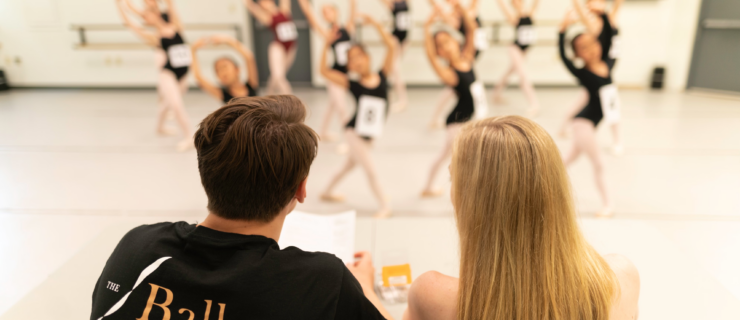A Look at a Tribute to Gus Giordano
This past spring, Giordano Jazz Dance Chicago wrapped up the nearly yearlong process of creating Giordano Moves, an homage to the classic style of the company’s legendary founder, Gus Giordano, 83.
“We don’t do a lot of Gus’s choreography anymore. We don’t see him a lot,” says Jon Lehrer, associate director of GJDC and longtime company member. “But the one thing everyone feels is that they wouldn’t be [dancing] if it weren’t for Gus. And the best way to give back to Gus Giordano is by creating and performing a tribute to his style of jazz dance.” In the past decade, classic jazz hasn’t proved to be especially popular or profitable for most concert dance companies, so for GJDC, the key to appealing to a modern audience was to take movements from Gus’s classic jazz technique and arrange them in one piece with a contemporary format.
Evolution of a Company
When Gus opened Chicago-based Giordano Dance Center in the 1950s, his mission was to prove that jazz dance could be a legitimate artform. “Ten years later, he started the company to show that jazz dance could be up there with modern and ballet on the concert dance stage,” Lehrer says.
As Gus grew older, he asked members of the company to choreograph more, enabling the company to depart from its classic jazz roots and tackle a more contemporary definition of concert jazz. “The Giordano technique is still very apparent,” says Gus’s daughter Nan. “But we now try to showcase a wide spectrum of jazz by bringing in diverse choreographers.” The torch was officially passed to Nan last year when the company dropped “Gus” from its name, though she’s been artistic director since 1993.
The Process
Lehrer spent last summer watching videotapes from the company archives with Gus, studying his book Anthology of American Jazz Dance and reviewing movement from Giordano-style class exercises. From this, Lehrer created a master list of raw data to use in Giordano Moves. In the fall, Lehrer put the movement together and worked with Nan to perfect the stylization. “Giordano Moves is so style-based, and if you don’t have the style, it doesn’t matter how great a dancer you are,” Nan says. “That has been the challenge.”
Lehrer collaborated with Chicago jazz musician George McCray, who created an original score for saxophone, piano, drums and bass, and with Joffrey Ballet lighting designer Kevin Dreyer, who used simple but dramatic lighting reminiscent of a jazz nightclub.
Lehrer paired with GJDC assistant associate director Kimberly Cunningham to experiment with the material and craft it into short segments. “We’d basically take the movement and, without changing it, find different ways of doing it—like how to transition from one movement to the next, and contemporize the flow of the piece,” Lehrer says. In January, they worked with the company to create variations and sequences, and cemented the arrangement.
Taking the Stage
In Giordano Moves, audiences will recognize the clean lines, groundedness and regal style of the Giordano jazz technique—signature positions and movements that harken to the lithographs in his book. While the piece isn’t a biography of his career, it shows “how all his movement can be put together and translate into a concert piece,” says Lehrer.
The piece begins with Lehrer alone in a spotlight center stage, performing iconic Giordano port de bras and movements in slow motion. “In essence, I’m playing Gus discovering this movement,” he says. “A light upstage right comes on, and a heavy drum comes in and two dancers do a quick eight-count movement and then the light shuts off on them and comes back on me. What that’s representing is what’s to come in Gus’s mind. It’s like I envision the future, and boom—we show it. And all this movement you see later, so it’s foreshadowing.” The piece merges into fast-paced stage crossings, duets, trios and groups, plus interludes for the men and women, which Gus often used. Lehrer describes one such moment: “The whole company is in the background walking and doing this great Giordano port de bras, and that melds into a circle. We all join hands, and the circle morphs into different shapes…and disperses.”
There was a hang up, however, about how to end the piece: “No one wanted to end with the usual ‘everyone dance together and finish,’” Lehrer says. Instead, the dancers show a moment of gratitude by observing Lehrer, again representing Gus, as he dances alone. “They are looking at me, and there’s a glow in their eyes and they’re thanking him—first by standing there watching, then by moving into his poses.”
Tactics for Reconstructing
When creating a piece based on historic work, spending as much time researching as choreographing is key. “I tried not to just look at the movement and copy it,” Lehrer says. “But I didn’t completely disregard [Gus’s] thought process. I had the luxury of having all this footage that showed what was going on in each piece. So when I was transferring [a step] I’d say, ‘He used this movement for a love duet, so I’m going to keep it in that vein.’”
The first time the company performed the piece for Gus was the sweetest reward for the long hours spent researching and rehearsing. The company created a hard-bound memory book for Gus and Nan and presented it to them at the premiere. Filled with photos of the rehearsal process, the book also contained a page for each company member’s photo and signature. “It was an experience that the dancers and all of us will live with forever,” says Nan. “It was his first night out in a very long time, and he came backstage and was in tears. [His] reaction was one of utter joy.”



